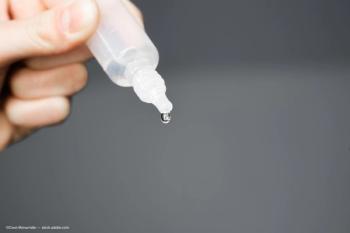
Resource use, cost of care: XFG versus POAG
Exfoliation glaucoma (XFG), the second most commonly occurring
Like POAG, it occurs bilaterally but also can manifest unilaterally, has higher peaks of IOP, faster deterioration of the visual fields, higher failure rates of medical therapy, and thus, a greater need for surgeries.
All of these factors point to the possibility that patients with XFG use more medical resources and incur more costs than patients with POAG, but the extent to which this is true is unknown.
Rathi and colleagues (
They commented that if there were differences in resource use and costs for patients with different types of glaucoma or severity of disease, these differences should be considered by insurers for alternative payment models to make sure that patients receive the best care.
RELATED:
The authors used a Medicare claims dataset to retrospectively identify Medicare beneficiaries with XFG and POAG and 5 years of longer continuous enrollment in Medicare from January 2008 to December 2014.
To determine if the patients were newly diagnosed with XFG and POAG or had pre-existing diseases, the patients could have no diagnoses of the diseases during their first 3 years of Medicare enrollment and must have had one or more visits to an eye care provider during that time, which would have provided the opportunity to be diagnosed.
The authors compared the use of ophthalmic resources and costs during a 2-year period among patients diagnosed with new and pre-existing XFG compared with patients with new and pre-existing POAG.
The main outcome measures, according to the investigators, were the number of visits to the clinic; the diagnostic procedures performed; the number of times medications were filled; the laser procedures and incisional surgeries performed; and the mean costs of eye care for each beneficiary.
RELATED:
Study results
Among 346,626 patients who were diagnosed with XFG or POAG during the study period, 99,312 patients met the inclusion criteria: 192 with newly diagnosed XFG and 7,339 with newly diagnosed POAG and 2,745 had pre-existing XFG and 89,036 with pre-existing POAG.
The authors reported that during the 2-year period the patients with newly diagnosed XFG and a higher mean number of clinic visits compared with the patients with newly diagnosed POAG (9.1 visits/patient versus 7.9 visits/patient, p = 0.001).
The patients with newly diagnosed XFG also underwent significantly (p < 0.0001) more diagnostic procedures, 5.0 versus 4.0 for those with POAG during the same period; the respective percentages of patients who underwent gonioscopy were 54.7% versus 37.0% (p < 0.0001) and fundus photography 47.9% versus 40.4% (p = 0.04).
Among patients with pre-existing XFG and pre-existing POAG, the respective mean numbers of office visits were 9.3 versus 7.3 (p < 0.0001).
Regarding diagnostic procedures, the same scenario was observed, with those with pre-existing XFG undergoing 4.3 tests versus 3.7 tests for those with pre-existing POAG; 39.4% versus 26.7%, respectively, underwent gonioscopy and 85.3% versus 79.8% underwent perimetry (p < 0.001 for both comparisons).
Regarding therapy, the patients with both newly diagnosed XFG and POAG filled at least one prescription for a glaucoma medication (p = 0.27).
However, those with newly diagnosed XFG underwent more laser or incisional procedures compared with those with newly diagnosed POAG (61.5% versus 44.7%, p < 0.0001), specifically, cataract surgery 34.9% versus 19.0% (p < 0.0001); when laser and incisional surgeries were considered together, more patients with newly diagnosed XFG underwent at least one procedure (28.7% versus 19.7%, p = 0.002).
Among patients with pre-existing XFG and POAG, more patients with pre-existing XFG (54.5%) underwent a laser or incisional procedure compared with 36.3% of those with pre-existing POAG, specifically, cataract surgery (23.4% versus 12.3%, laser trabeculoplasty (18.6% versus 9.6%), and trabeculectomy (8.1% versus 1.8%) (p < 0.0001 for all comparisons).
Costs were 27% higher among the patients with newly diagnosed XFG compared with newly diagnosed POAG ($3,260 versus $2,562, p = 0.0001). Specifically, the costs were higher for those with newly diagnosed XFG for eye clinic visits ($890 versus $717, p = 0.0001), diagnostic testing ($523 versus $378, p = 0.0006), and cataract surgery ($853 versus $465, p = 0.0001).
RELATED:
Among the patients with pre-existing disease, the costs were 37% higher among those with pre-existing XFG ($3,764 versus $2,739, p < 0.0001). As with newly diagnosed disease, all of the costs for the other parameters also were higher for those with pre-existing XFG: clinic visits ($859 versus $663, p < 0.0001), diagnostic testing ($410 versus $340, p < 0.0001),cataract surgery ($494 versus 271, p < 0.0001), glaucoma medications ($1,471 versus $1,279, p < 0.0001), and glaucoma surgery ($531 versus $186, p < 0.0001).
The authors concluded, “…healthcare resource utilization and cost associated with caring for patient with XFG are significantly higher compared to others with POAG on almost every metric we evaluated. The findings from these analyses highlight the importance of considering the type of glaucoma, its severity, and the length of time when insurers and policymakers develop algorithms for alternative payment models to ensure patients are able to receive high-quality, cost effective care.”
RELATED:
Newsletter
Don’t miss out—get Ophthalmology Times updates on the latest clinical advancements and expert interviews, straight to your inbox.















































